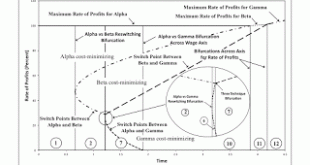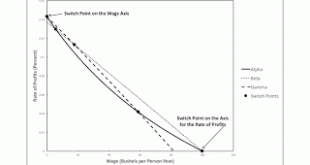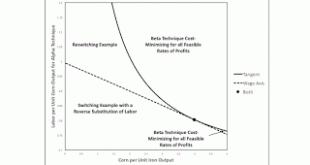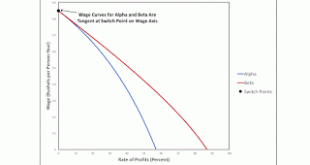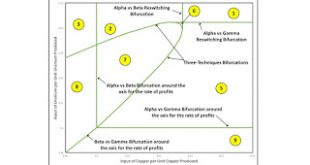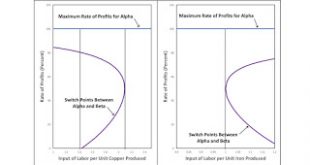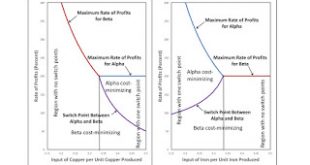Variation of Switch Points with Technical Progress in Two Industries I have a new working paper - basically an update of one I have previously described. Abstract: This article illustrates the application of bifurcation analysis to structural economic dynamics with a choice of technique. A numerical example of the Samuelson-Garegnani model is presented in which technical progress is introduced. Examples of temporal paths through the parameter space illustrate variations of the wage...
Read More »An Example With Two Fluke Switch Points
Figure 1: Fluke Switch Points on Each Axis1.0 Introduction I have developed an approach for finding examples in which either two fluke switch points exist on the wage frontier or a switch point is a fluke in more than one way. This post presents a numerical example with two fluke switch points on the frontier. Not all examples generated by this approach are necessarily interesting, although I find the approach of interest. I don't think the example in this approach is all that...
Read More »Structural Economic Dynamics with a Choice of Technique: A Numerical Example
A Bifurcation Diagram with Two Temporal Paths I have a working paper with the post title. Here's the abstract: This article illustrates the application of bifurcation analysis to structural economic dynamics with a choice of technique. A numerical example of the Samuelson-Garegnani model is presented in which technical change is introduced. Examples of temporal paths through the parameter space illustrate variations of the wage frontier. A single technique is initially uniquely...
Read More »Another Example Of A Real Wicksell Effect Of Zero
Bifurcation Diagram for Fluke Switch Point
Figure 1: A Bifurcation Diagram I have previously illustrated a case in which real Wicksell effects are zero. I wrote this post to present an argument that that example is not a matter of round-off error confusing me. Consider the technology illustrated in Table 1. The managers of firms know of three processes of production. These processes exhibit Constant Returns to Scale. The column for the iron industry specifies the inputs needed to produce a ton of iron. Two processes are known for...
Read More »A Fluke Switch Point With A Real Wicksell Effect Of Zero
Figure 1: A Fluke Switch Point1.0 Introduction A switch point in which the wage curves for two techniques are tangent to one another at the switch point is a fluke. Likewise, a switch point that occurs at a rate of profits of zero is a fluke. This post presents a two-commodity example with a choice between two techniques, in which the single switch point is simultaneously both types of flukes. The wage curves are tangent at the switch point, and the switch point occurs at a rate of...
Read More »Example With Four Normal Forms For Bifurcations Of Switch Points
Figure 1: A Blowup of a Bifurcation Diagram1.0 Introduction I have been working on an analysis of structural economic dynamics with a choice of technique. Technical progress can result in a variation in the switch points and the succession of techniques with wage curves on the outer wage frontier. I call such a variation a bifurcation, and I have identified normal forms for four generic bifurcations. This post prevents an example in which all four generic bifurcations appear. 2.0...
Read More »A Reswitching Bifurcation, Reflected
Figure 1: Two Bifurcation Diagrams Horizontally Reflecting1.0 Introduction This post continues my investigation of structural economic dynamics. I am interested in how technological progress can change the analysis of the choice of technique. I have four normal forms for how switch points can appear on or disappear from the wage frontier, as a result of changes in coefficients of production. This post concentrates on what I call a reswitching bifurcation. Each bifurcation can be...
Read More »Switch Points and Normal Forms for Bifurcations
I have put up a working paper, with the post title, on my Social Sciences Research Network (SSRN) site. Abstract: The choice of technique can be analyzed, in a circulating capital model of prices of production, by constructing the wage frontier. Switch points arise when more than one technique is cost-minimizing for a specified rate of profits. This article defines four normal forms for structural bifurcations, in which the number and sequence of switch points varies with a variation in...
Read More »Switch Points Disappearing Or Appearing Over The Axis For The Rate Of Profits
Figure 1: Two Bifurcation Diagrams Horizontally Reflecting1.0 Introduction This post continues my investigation of structural economic dynamics. I am interested in how technological progress can change the analysis of the choice of technique. In this case, I explore how a decrease in a coefficient of production can cause a switch point to appear or disappear over the axis for the rate of profits. 2.0 Technology Consider the technology illustrated in Table 1. The managers of firms know...
Read More » Heterodox
Heterodox

